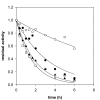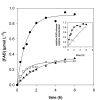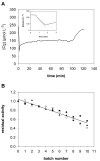The stabilizing effects of immobilization in D-amino acid oxidase from Trigonopsis variabilis
- PMID: 18798979
- PMCID: PMC2557008
- DOI: 10.1186/1472-6750-8-72
The stabilizing effects of immobilization in D-amino acid oxidase from Trigonopsis variabilis
Abstract
Background: Immobilization of Trigonopsis variabilis D-amino acid oxidase (TvDAO) on solid support is the key to a reasonably stable performance of this enzyme in the industrial process for the conversion of cephalosporin C as well as in other biocatalytic applications.
Results: To provide a mechanistic basis for the stabilization of the carrier-bound oxidase we analyzed the stabilizing effects of immobilization in TvDAO exposed to the stress of elevated temperature and operational conditions. Two different strategies of immobilization were used: multi-point covalent binding to epoxy-activated Sepabeads EC-EP; and non-covalent oriented immobilization of the enzyme through affinity of its N-terminal Strep-tag to Strep-Tactin coated on insoluble particles. At 50 degrees C, the oriented immobilizate was not stabilized as compared to the free enzyme. The structure of TvDAO was stabilized via covalent attachment to Sepabeads EC-EP but concomitantly, binding of the FAD cofactor was weakened. FAD release from the enzyme into solution markedly reduced the positive effect of immobilization on the overall stability of TvDAO. Under conditions of substrate conversion in a bubble-aerated stirred tank reactor, both immobilization techniques as well as the addition of the surfactant Pluronic F-68 stabilized TvDAO by protecting the enzyme from the deleterious effect of gas-liquid interfaces. Immobilization of TvDAO on Sepabeads EC-EP however stabilized the enzyme beyond this effect and led to a biocatalyst that could be re-used in multiple cycles of substrate conversion.
Conclusion: Multi-point covalent attachment of TvDAO on an isoluble porous carrier provides stabilization against the denaturing effects of high temperature and exposure to a gas-liquid interface. Improvement of binding of the FAD cofactor, probably by using methods of protein engineering, would further enhance the stability of the immobilized enzyme.
Figures






Similar articles
-
Oriented and selective enzyme immobilization on functionalized silica carrier using the cationic binding module Z basic2: design of a heterogeneous D-amino acid oxidase catalyst on porous glass.Biotechnol Bioeng. 2012 Jun;109(6):1490-8. doi: 10.1002/bit.24423. Epub 2012 Jan 17. Biotechnol Bioeng. 2012. PMID: 22249953
-
Thermal inactivation of D-amino acid oxidase from Trigonopsis variabilis occurs via three parallel paths of irreversible denaturation.Biotechnol Bioeng. 2006 Jul 5;94(4):645-54. doi: 10.1002/bit.20854. Biotechnol Bioeng. 2006. PMID: 16538681
-
Stabilization of native and double D-amino acid oxidases from Rhodosporidium toruloides and Trigonopsis variabilis by immobilization on streptavidin-coated magnetic beads.Biotechnol Lett. 2008 Nov;30(11):1973-81. doi: 10.1007/s10529-008-9782-6. Epub 2008 Jul 2. Biotechnol Lett. 2008. PMID: 18594772
-
Stability and stabilization of D-amino acid oxidase from the yeast Trigonopsis variabilis.Biochem Soc Trans. 2007 Dec;35(Pt 6):1588-92. doi: 10.1042/BST0351588. Biochem Soc Trans. 2007. PMID: 18031272 Review.
-
D-Amino acid oxidase: structure, catalytic mechanism, and practical application.Biochemistry (Mosc). 2005 Jan;70(1):40-54. Biochemistry (Mosc). 2005. PMID: 15701048 Review.
Cited by
-
Interaction of D-amino acid oxidase with carbon nanotubes: implications in the design of biosensors.Anal Chem. 2009 Feb 1;81(3):1016-22. doi: 10.1021/ac802068n. Anal Chem. 2009. PMID: 19132842 Free PMC article.
-
Combining a Genetically Engineered Oxidase with Hydrogen-Bonded Organic Frameworks (HOFs) for Highly Efficient Biocomposites.Angew Chem Int Ed Engl. 2022 Apr 11;61(16):e202117345. doi: 10.1002/anie.202117345. Epub 2022 Feb 24. Angew Chem Int Ed Engl. 2022. PMID: 35038217 Free PMC article.
-
A genome-informed higher rank classification of the biotechnologically important fungal subphylum Saccharomycotina.Stud Mycol. 2023 Jun;105:1-22. doi: 10.3114/sim.2023.105.01. Epub 2023 May 25. Stud Mycol. 2023. PMID: 38895705 Free PMC article.
-
Improving activity and enantioselectivity of lipase via immobilization on macroporous resin for resolution of racemic 1- phenylethanol in non-aqueous medium.BMC Biotechnol. 2013 Oct 29;13:92. doi: 10.1186/1472-6750-13-92. BMC Biotechnol. 2013. PMID: 24168516 Free PMC article.
-
Stepwise engineering of a Pichia pastoris D-amino acid oxidase whole cell catalyst.Microb Cell Fact. 2010 Apr 26;9:24. doi: 10.1186/1475-2859-9-24. Microb Cell Fact. 2010. PMID: 20420682 Free PMC article.
References
-
- Pilone MS, Pollegioni L. D-Amino acid oxidase as an industrial biocatalyst. Biocat Biotrans. 2002;20:145–159. doi: 10.1080/10242420290020679. - DOI
-
- Tishkov VI, Khoronenkova SV. D-Amino acid oxidase: Structure, catalytic mechanism, and practical application. Biochemistry (Moscow) 2005;70:40–54. - PubMed
-
- D'Souza S, Deshpande A. Simultaneous purification and reversible immobilization of D-amino acid oxidase from Trigonopsis variabilis on a hydrophobic support. Appl Microb Biotechnol. 2001;95:83–92. - PubMed
MeSH terms
Substances
LinkOut - more resources
Full Text Sources

